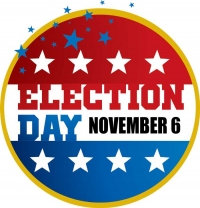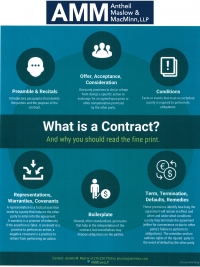Estate Planning attorney Elaine Yandrisevits the firm's Estates and Trusts practice group spoke on Special Needs Trusts at a program hosted by Firstrust Financial Resources. The November 6th program, entitled “Understanding Government Benefits for a Special Needs Loved One” also featured speakers Jerel Ruttenberg & Brian C. Smith, of Firstrust Financial Resources, and was focused on best approaches to financial and estate planning for a family member with special needs, including the uses of Special Needs Trusts and ABLE Accounts.
Elaine practices exclusively in the Estates and Trusts department at Antheil Maslow & MacMinn in Doylestown, Pennsylvania. She focuses her practice on estate planning, trusts and estate administration and assists with fiduciary litigation matters. With a great deal of practical experience with special needs trust planning and guardianships, Elaine is a frequent speaker on estate planning, estate administration, and special needs planning for continuing legal education and community organizations.
The Spark Bowl at Delaware Valley University: A Business Lawyer’s on Take Entrepreneurship
Written by Christopher D. WagnerAs a business lawyer, I have spent years counseling small to mid-sized companies across a wide range of industries. I have advised clients on routine to complex business legal issues that arise during the start-up stage through operation and growth stages, and have structured many exit strategies and created successful succession plans in various ownership documents. What I love best about providing sound legal guidance to business owners through the life cycle of their business is helping them solve issues that arise both from a legal perspective and also from a financial perspective. Helping clients navigate through contractual, employment, finance, IP protection, and other daily issues so they can focus on achieving their goals of growth, maximization of profits, and sustainability, all while minimizing their potential for risk and exposure is a vital objective in my practice.
I have recently been invited to participate for the next several weeks as an advisor in an exciting new local event – The Spark Bowl. Co-sponsored by Delaware Valley University, it’s Small Business and Entrepreneurship Center and the Central Bucks Chamber of Commerce, this event is a local competition aimed at fostering innovation, growth, and entrepreneurship. At the First Annual Spark Bowl event to be held on December 11th, students and local entrepreneurs in and around Bucks County will “pitch” their businesses plans to Spark’s judges, who will select a winner who will receive prizes and benefits to include monetary funding as well as access to expert advisors. The contest will be judged by experienced investors who have a desire to support innovation and economic growth and prosperity within the local community. As part of DelVal’s experiential learning program, DVU student teams will work with final contestants to prepare for the competition under the guidance of DelVal faculty and SBEC advisors. Professor William Viel of DVU’s Business and Information Management Department is the Director of the SBEC. It is quite a valuable resource to this community to have such an incubator right here in Central Bucks. Please click here to learn more about The Spark Bowl at Delaware Valley University.
After many years of working with business owners, some who were successful, and some who were not, it seems evident that the best predicator of sustainable business growth and success is: planning by asking the right questions up-front; creating detailed business plans and product or service models; determining the expected demand for their product or service in a low or highly competitive market; understanding both traditional and non-traditional financing alternatives; putting together the right team of professionals to help them produce, deliver and promote their business and its products/services; dealing with operational challenges and various levels of legal compliance properly, all while being willing to assess weaknesses and promote strengths.
The Spark Bowl has inspired me to remind my clients to think about why they are doing what they are doing, as they work through the day-to-day challenges (legal and otherwise) of operating and sustaining a business they built and love.
Good Luck to all the participants on December 11th!
From a Litigator’s Desk: Minority Business Ownership – Know Your Limits
Written by Thomas P. DonnellyMany an article or blog post concerns minority shareholder rights, shareholder oppression or shareholder “freeze out”. As business and litigation lawyers, we are always mindful of the rights between and among business owners, what can and cannot be done in furtherance of those rights and the legal mechanisms applicable to the exercise of those rights. We frequently write on the strategies available to a minority shareholder such as examination of books and records, claims of breach of fiduciary duty and the potential for appointment of a corporate receiver or custodian.
This is not that article.
The fact is, being a minority shareholder means that, by definition, there are often things you simply cannot control. A shareholder or member in a business entity who possesses less than a controlling stake must have reasonable expectations as to the rights attendant to such ownership and understand the limits of such rights so as to make informed decisions concerning the investment of time, energy and money in pursuit of the collective enterprise.
Let’s start with who owns the remaining shares in the company. In the absence of an agreement to the contrary, the majority shareholder is free to transfer the majority (said another way; controlling) interest in the company without the consent of the minority. A transaction can result in a change in control such that the minority shareholder suddenly works for someone entirely new. While a minority shareholder can enjoy “dissenter’s rights”, such rights are applicable in very narrow situations specified by statute. In fact, in the absence of a prohibition, the stock in a business entity is readily transferrable, just like on an exchange, if a buyer and/or seller can be identified.
Internally, a minority shareholder can find it difficult to impact the direction of the business. Depending on the by-laws of the entity and, frankly, the will of the majority, a minority shareholder may or may not have a voice on the board of directors and thus may not possess a vote on material decisions such as the persons who will fulfill critical roles in the executive branch of the business such as the officers of the corporation. More importantly, a minority shareholder may not have input on the financial operations of the company including distributions, financing arrangements, major purchases of inventory, equipment or talent. All of which can dramatically affect the annual bottom line.
Even employment is not guaranteed to a minority in interest. In the absence of an agreement to the contrary, the employment of a minority shareholder may simply be at will in the same way as the sales force, the administrative assistants or the custodian. Certainly, terminating a minority’s employment could be one of the factors argued in a freeze out, but in the absence of other factors, termination of employment alone may not give rise to a cause of action. Certain courts have suggested continued employment may be implicit in a “founder” but those situations are few and far between and a plaintiff/minority shareholder must be prepared with more to argue than the end of employment if freeze out is alleged.
In business, like politics, being in the minority means sometimes you are powerless to immediately change the course of the company. Sometimes, a group of shareholders can band together to pool their collective influence for their mutual benefit. Other times, the best strategy is to become the majority even when the acquisition of additional shares comes at an unnecessary or unanticipated cost. Under any circumstances, rights afforded to the majority are not constrained solely because a minority shareholder does not agree with a particular course of action.
As a litigator, I am often contacted by minority shareholders who are frustrated by their lack of control or influence. While the law offers certain protection for holders of such minority interests, those remedies are factually limited and are often unsatisfactory even if granted in full after significant expense in litigation. Certainly an appropriate agreement outlining the respective rights and obligations can change the analysis. Business owners should consider, and plan for, what rights their stake in the company provides.
What is a Contract: Part 4: Representations, Warranties, Covenants - The Bones of the Agreement.
Written by Joanne MurrayThis is the fourth installment of my continuing blog series explaining the main elements of a contract, which are outlined on the attached infographic . My goal is to demystify some of these basic provisions to help business owners have a better general understanding of what they are signing.
This article discusses representations, warranties, and covenants, which are the “bones” of the parties’ agreement. These provisions represent the statements of the underlying facts, mutual assurances, and promises of performance which form the basis of the parties’ mutual understanding. It’s not uncommon to find these concepts used interchangeably in a contract – “ABC represents, warrants, and covenants…”, but the meaning and effect of each of these are quite distinct from one another. It’s important to understand these distinctions so that your contracts accurately reflect the assumptions, obligations, and risks that you are comfortable with.
A representation is a statement of past or present fact (either express or implied) made by one party to induce the other party to enter into the agreement. For example, the seller of a business might represent that gross revenues from the business were a certain dollar amount for the past several years or that there are no claims asserted against the business. If a representation proves to have been untrue when made, the injured party will have a claim of fraudulent misrepresentation if she can prove that: (i) the party making the representation knew or should have known the statement was false when made; (ii) the other party intended the injured party to rely on the statement; and (iii) the injured party’s reliance on the statement in entering into the agreement was justifiable. The injured party can seek monetary damages for its losses or it may ask the court to rescind (void) the entire contract. It is therefore very important to avoid “over-representing” in your contracts.
A warranty is essentially a promise that an assertion made by a party is true, coupled with an implied promise of indemnity if the assertion made by the party is false. As such, a warranty is both present-focused, like a representation, and forward-looking, like a covenant. If a warranty is breached, the injured party is entitled to be made whole; this usually means that the injured party can recover the difference between the value of the contract as agreed upon and the value of the contract in light of the breach. In other words, the injured party is entitled to receive the benefit of the bargain he initially made. The injured party is not required to demonstrate that he relied on the warranty or that the other party knew that the warranty was false when made.
Often, but not always, representations and warranties go hand-in-hand to allow the parties to preserve remedies that are as broad as possible. In complex agreements, the parties usually spend a significant amount of time negotiating how the risks embodied by representations and warranties should be allocated by qualifying and limiting these concepts (e.g., a representation is true to the best of the maker’s knowledge and/or in all material respects).
Product and service warranties are specialized contractual provisions that are actually hybrids of representations, warranties, and covenants. These provisions commonly create limited express warranties that apply to the products or services, identify specific contractual remedies for breach, and disclaim implied warranties that are provided by law.
A covenant is a party’s promise to perform an action or to refrain from performing an action. It relates to the future, as opposed to representations, which are provided as of a specific date. An example of a covenant is a borrower’s promise to make loan payments in accordance with the terms of a promissory note. Covenants can be express or implied. Pennsylvania law imposes an implied covenant of good faith and fair dealing in most contracts.
Stay tuned for Part 5 of this series, which will move on to discuss some possible hidden perils of what is commonly dismissed as “just boilerplate” language.
On Tuesday, November 5th, voters will be casting ballots to fill two seats on the Superior Court of Pennsylvania. Voters also will be deciding whether to retain two judges on the Superior Court of Pennsylvania and two judges on the Commonwealth Court of Pennsylvania.To better inform voters about the candidates in this statewide election, the Pennsylvania Bar Association Judicial Evaluation Commission (PBA JEC) is reissuing its ratings and descriptive paragraphs for all appellate judge candidates appearing on the Nov. 5 ballots.
In order to help you to make an informed decision, we have linked that review here for your reference.
Here in Bucks County, six candidates are running for Common Pleas Judge. Last Spring, the Bucks County Bar Association (“BCBA”), an organization of attorneys dedicated to promoting and advancing the legal system and justice throughout Bucks County, conducted a plebiscite (peer evaluation) to evaluate ten attorneys who announced their candidacy for three vacancies on the Bucks County Court of Common Pleas, and the four current judges of the Bucks County Court of Common Pleas who are running for retention. Please note, this evaluation was done prior to the May primary election, please refer to the table below for the evaluations of the six remaining candidates who will appear on the ballot on November 5th in the highly recommended, recommended and not recommended categories. The remaining candidates for the three judicial vacancies are Denise M. Bowman, Grace Deon, Charissa Liller, Allen Toadvine, Jessica Vanderkam, and Jordan Yeager. If you wish to review the original evaluations, here is a link to the plebiscite results.
|
Candidate |
Highly Recommend |
Recommend |
Not Recommended |
|
Denise Bowman |
104 |
92 |
21 |
|
Grace Deon |
193 |
88 |
15 |
|
Charissa Liller |
26 |
45 |
165 |
|
Allen Toadvine |
95 |
92 |
26 |
|
Jessica VanderKam |
35 |
60 |
121 |
|
Jordan Yeager |
150 |
77 |
29 |
Additionally, the members of the Bucks County Bar Association were asked to provide their opinions if the following Judges should be retained in office as a Judge of the Court of Common Pleas of Bucks County. Here are the results in the endorsed and not endorsed categories:
|
Candidate |
Endorsed |
Not Endorsed |
|
Hon. Robert Baldi |
318 |
16 |
|
Hon. Wallace Bateman |
320 |
4 |
|
Hon. Gary Gilman |
310 |
11 |
|
Hon. Alan Rubenstein |
306 |
17 |
However you may choose to vote, please do remember Election Day, Tuesday, November 5th.
Attention Employers: New Department of Labor Ruling on Overtime Pay
Written by Patricia CollinsOn September 24, 2019, the United States Department of Labor announced a new final rule regarding eligibility for overtime pay. The rule requires employers to revisit their classifications of employees as exempt in order to ensure compliance.
As I discussed in previous articles (Texas Federal Judge Blocks New Overtime Rules and Speaking of Overtime Rules and One Final Overtime Update) the DOL announced rules in 2016 to dramatically increase the salary threshold in order for certain categories of employees to meet the standards for exemption from federal overtime requirements. The rules were met with litigation and a stay of their enforcement.
The new final rule raises the salary threshold from $455 a week to $684 a week, or $35,568 a year. Employers may now use nondiscretionary bonuses and incentive payments, such as commissions to satisfy up to 10% of the salary level. Employees will still have to meet requirements related to their duties in order to meet the standards of exemption for the overtime requirements.
This final rule will become effective on January 1, 2020. As we advised in 2016, employers should take steps to ensure compliance by the end of the year. The first step is to identify any employees who are classified as exempt but are making less than $422 a week, and develop a plan to reclassify those employees, or revise their compensation. This is a good time to revisit the job duties of those employees to ensure that they meet the applicable standards for exemption in terms of their duties as well as their salary. This is also a good time to review overtime policies to ensure appropriate recordkeeping, efficient use of overtime and compliance with applicable law.
AMM can help employers navigate these new rules and review their employee classifications to ensure compliance and minimize risk.
Susan Maslow, Co-Founder and Partner of Antheil Maslow & MacMinn in Doylestown, PA was the Chair and Moderator of a program entitled BUSINESS AND ETHICAL CHALLENGES: HUMAN RIGHTS REQUIREMENTS, DUE DILIGENCE, REMEDIATION AND BRAND PROTECTION during the ABA Business Law Section’s Annual Meeting in Washington D.C. on Saturday, September 14, 2019.
The Panel Discussion provided a brief summary of the cycle of human rights violations in supply chains and summarized the growth of legislation, litigation and investor focus on supply chain human rights issues and provided practical contracting and due diligence recommendations, tools and risk assessment procedures to avoid human rights abuses including use of the 2018 Model Clauses for international supply chains published in the 2018 fall issue of The Business Lawyer. Informed by the Panelists’ knowledge of global policies and procedures, advice was provided as to how to develop an enterprise-wide understanding of, and commitment to, human rights (health and safety requirements, anti-forced labor, child labor and indentured labor constraints) while optimizing market-specific approaches.
Ms. Maslow is a business attorney concentrating her practice primarily in general corporate transactional work and finance documentation in the areas of Business Transactions, Business Law, Private Finance, Real Estate, Contracts, and Non-Profit Law.
What is a Contract: Part 3: Conditions - When Is a Promise No Longer a Promise?
Written by Joanne MurrayThis post continues my series explaining the main elements of a contract, which are outlined on the attached infographic. My goal is to demystify some of these basic provisions to help business owners have a better general understanding of what they are signing.
Another key element of a typical contract is a condition. A condition is an event that must occur or a fact that must be true before a party is obligated to perform his obligations under a contract. Conditions are used to allocate risk by making a party’s obligations, which would otherwise be absolute, dependent on circumstances that are usually outside of that party’s control. The risk of those circumstances not occurring is thus shifted to the other party. For example, your agreement to buy a parcel of real estate might be conditioned on your ability to obtain financing. If you are unable to get financing, you are not obligated to proceed with the sale. Your failure to perform your obligations is excused and is not a breach; the seller will have no claim for damages against you based on your failure to perform. A condition is not necessarily tied to a third party’s performance of an action (such as a bank agreeing to lend money to the buyer) but is sometimes linked to the performance of an obligation by the other party. Some conditions are dependent on weather or similar events that are altogether outside of the contracting parties’ and third parties’ control.
Sometimes a condition is drafted so that its non-fulfillment excuses some, but not all, of a party’s obligations under the agreement. As a result, if the condition is not met, the agreement remains in force as to all other obligations. On the other hand, a condition may be drafted so that the entire agreement will terminate if the condition is not satisfied (such as the property sale example above). It is important to note that the party benefitting from the condition may choose to waive the condition and proceed with performance under the agreement. Further, if the party whose obligations are conditioned performs those obligations even though the condition has not been satisfied, he may be deemed to have waived the condition.
Conditions are not necessarily identified in a single specific section of a contract, but often are sprinkled throughout the agreement where the parties’ obligations are identified. Because of the impact of an unsatisfied condition, it is important to be able to recognize conditions on the other party’s obligations before you enter into the agreement. Look for words such as “if”, “provided that”, “in the event that”, “subject to”, “on the condition that”, “conditioned on”, and “contingent on”.
Before you sign any contract, you should be sure to assess whether any of your obligations should be conditioned on the occurrence of facts or events. If so, it is important that those conditions be clearly identified. Similarly, you should review the agreement to identify any conditions to the other party’s obligations and their impact on the agreement overall and your rights under the agreement. Ask yourself:
• Does the agreement set out unrealistic, vague or unpredictable conditions under which the other party could be released from its contractual obligations to me? Will I have incurred unnecessary expenses prior to the determination whether the condition has been satisfied (e.g., purchase of supplies or services)?
What impact will a release of the other party’s obligations have on my business (e.g., finding a substitute vendor)?
• What actions or omissions (by me or key staff) could result in a release of the other parties’ contractual obligations?
• Are any conditions on my performance needed to provide a way out in the case of prohibitive or unacceptable changes in circumstances down the line?
In summary, contractual agreements will ultimately only yield the intended benefits to your business if they are enforceable, and that means understanding under what conditions some or all of the other party’s obligations might be excused.
Stay tuned for Part 4 of this series, which will move on to the next contract element shown on the infographic: Representations, Warranties, and Covenants.
Elaine T. Yandrisevits, an estate planning and administration attorney with Antheil Maslow & MacMinn, LLP in Doylestown, PA, is a course planner and will serve as faculty for Pennsylvania Bar Institute’s upcoming “Administering an Estate in PA: A Step-by-Step Guide” continuing education program in September. The seminar is a comprehensive overview of the estate administration progress in Pennsylvania from beginning to end for attorneys, paralegals, and accountants. Ms. Yandrisevits will be presenting at the live seminar in Philadelphia on September 5. Registration and information on additional dates, including a the live webcast, can be found at www.pbi.org
Important Reminder for Home Improvement Contractors in Pennsylvania
Written by Stephanie M. ShortallIn 2008, Pennsylvania enacted the Home Improvement Consumer Protection Act (HICPA) designed to protect home owners from unscrupulous contractors. However, it is also a trap for the unwary home improvement contractors. In addition to its registration requirements, HICPA specifies what must be in a contract for home improvement services and what may not be in these contracts.
HICPA applies not only to contractors performing renovations and remodels, but also many other types of services including most landscaping work, security systems, fencing companies and concrete work. Any individual or company performing these services needs to be aware of the requirements imposed by HICPA and can read more in this client alert.










